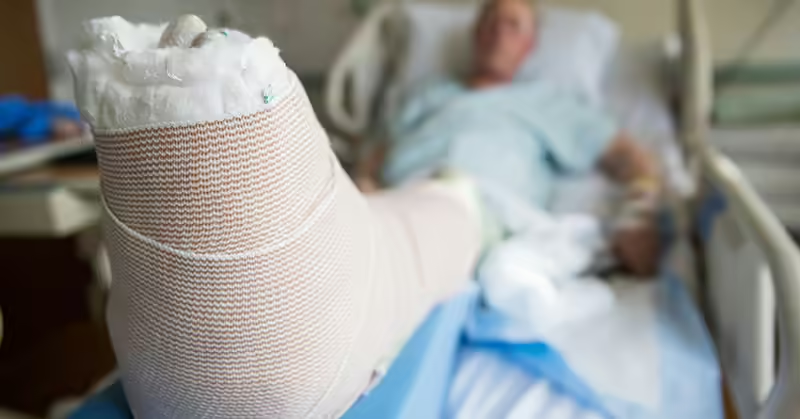Compensation for Burn Injuries
June 1, 2020

If an individual suffers a severe burn injury by the fault of another, there are important considerations when evaluating damages. The pain a burn victim suffers is likely obvious and can be conveyed easily to a jury or opposing party. However, burn injuries are unlike broken bones or soft tissue injuries, and require important examination to maximize a claim against another party. Attorneys at Morrow & Sheppard LLP have fought for burn victims and evaluated the complexities of burn injuries on behalf of our clients.
Physical Injuries Resulting from Burns
For a burn injury case, the physical injuries to a burn victim are the primary and obvious source of recovery. However, it is important to understand the severity and classifications of burns to help a jury understand the variance of appropriate treatments, the pain involved, and long-term effects.
Superficial Burns
These are non-deep burns that are painful. They can include first or second-degree burns. First-degree superficial burns cause damage above the basal layer of the epidermis. Second-degree superficial burns are extremely painful, and cause:
- Moisture on the skin
- Redness
- Blanching
- Blisters
They heal by “re-epithelialization from skin adnexa,” meaning that either the skin naturally heals the wound or may require plastic surgery. The deeper the burn, the slower it heals.
Deep Burns
These range from second to fourth-degree. Deep burns generally require skin grafting and can lead to hypertrophic (raised) scars if they are not grafted.
- Deep second-degree burns cause damage to the deeper dermis. They cause less moisture of the skin than superficial burns, less blanching, and less pain. They heal by scaring and limited re-epithelialization.
- Deep third-degree burns destroy the entire thickness of the skin and go into the fat. They range in color and only heal by contraction and scarring.
- Deep fourth-degree burns are not generally recognized by laypeople but are severe. These burns reach into the muscle, tendon, and bone. They require specialized care because grafting will not work.
Attorneys should recognize the interplay between insurance coverage for burn victims on the front end, and possible damages sources from a defendant who caused a burn. Burn victims must be operated on quickly to achieve good results. Long-term, burn victims can require unique care that should be accounted for when arguing with a jury. At-fault parties will attempt to have experts claim that burn victims are healed or cannot be treated further at the time of trial. Often, they will purposefully avoid discussions of prosthetics and elective surgeries to make a burn victim “whole” again. In Texas, lawsuits must generally be filed within two years of the date of a burn injury. This means that treatment can be ongoing at the time the case reaches a jury. Your attorney should understand life-care planning and be able to consult experts who can calculate future damages so that you can afford all necessary future care.
PTSD and Psychological Injuries to Burn Victims
Aside from the extensive list of physical injuries and ailments that result from burns, burn injuries are mentally devastating. Often a burn victim will be treated by medical staff immediately, without regard to the psychological damage that follows. The trauma of a burn injury can lead to serious social and psychological consequences, and deeply impact the quality of life for burn victims regardless of physical healing. Treatment for burns often requires isolation, which can increase the likelihood of the onset of psychological disorders. Moreover, bodily disfigurement in burn victims can cause a mental burden to a victim long after treatment for the physical ailments is complete. An analysis of psychological well-being in a burn victim is vital to maximizing compensation. Your attorney should be prepared to analyze treatment for psychological disorders and guide a jury to understand the unique disorders commonly associated with burns.
The Likelihood of PTSD after a Burn Injury:
The prevalence of psychological disorders in burn victims is staggering. The American Journal of Clinical Dermatology reported that 90% of burn victims experience stress symptoms within one week of the injury. Within 3-6 months of the burn injury, up to 33% of burn victims experience symptoms that indicate PTSD. After one full year, 45% of burn victims develop signs of chronic stress that can be categorized as Post-Traumatic Stress Disorder (PTSD).
PTSD stems from a triggering event, like a severe burn. Injuries that require long-term medical care, like burns, often exacerbate psychological problems and can affect mental recovery. The development of PTSD in situations like this can be vicious and can be worsened by a lengthy recovery.
What to Look For
Medical professionals trained to treat burns are often not fully trained to screen for psychological issues. Therefore, it is important to seek out qualified psychologists and/or psychiatrists to help identify and treat non-physical injuries. The Diagnostic and Statistical Manual of Mental Disorders, Fifth Edition (DSM) lays out the diagnostic criteria that must be met to diagnose PTSD. In burn victims, some or all of the criteria are likely found. While the list is large, some common effects of PTSD in burn victims are:
- Nightmares
- Flashbacks
- Distress after exposure to traumatic reminders
- Inability to recall key features of the trauma
- Decreased interest in activities
- Feeling isolated
- Irritability or aggression
- Hypervigilance
- Heightened startle reaction
- Difficulty sleeping
- Functional impairment (social or occupational)
Other Psychological Disorders Found in Burn Victims
- Delirium: “Disturbance of consciousness (i.e., reduced clarity of awareness of the environment) occurs, with reduced ability to focus sustain, or shift attention”
- Major Depressive Disorder: Symptoms include: sadness, hopelessness, loss of interest or pleasure in activities, loss or gain of weight, lack of energy, feeling of worthlessness
- Anxiety Disorders: a multitude of disorders are encompassed by anxiety, that severely hinder one’s ability to function normally
Juries in Texas must be informed by lawyers that these symptoms and criteria relate to damages in a lawsuit for pain and suffering, or loss of enjoyment of life, and many other claims. Aside from physical injuries from a burn, these symptoms, disorders, and criteria should not be minimized. Experienced burn injury lawyers at Morrow & Sheppard LLP have worked with burn victims and can maximize your compensation for burn injuries with an in-depth understanding of the psychological effects of burns. Call the attorneys at Morrow & Sheppard LLP for a free, confidential consultation if you or a loved one have suffered a burn injury.
Morrow & Sheppard, LLP represents burn victims in Texas, New Mexico, and Louisiana including those located in Midland, Odessa, Lovington, Houston, Hobbs, Carlsbad, Roswell, Lake Charles, Baton Rogue, Lafayette, and the surrounding communities, and across the United States.
Nick Morrow is a trial and personal injury lawyer who has been repeatedly designated as a Super Lawyer. Nick has recovered millions of dollars for deserving clients nationwide. He has handled a variety of business and all types of personal injury cases involving work-related negligence, including but not limited to oilfield injuries, maritime injuries, work injuries, and wrongful death. You can learn more about Nick here.
- Home
- |
- Burn Injuries
- |
- Compensation for Burn Injuries
















































